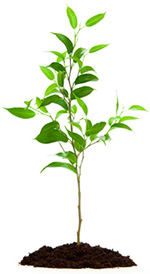|
We have all heard about how trees help the environment, but do we know how exactly? Metaphorically, trees are like the lungs of the planet. They breathe in carbon dioxide and breathe out oxygen. What does this mean?

Carbon Dioxide or CO2 is one of the major contributing elements to the greenhouse effect. Trees trap CO2 from the atmosphere. Studies have shown that urban forests of the U.S store 800 million tons of. Mature trees can absorb roughly 48 pounds of CO2 a year. The tree in turn releases enough oxygen to sustain two human beings.
In urban areas, trees can help reduce urban runoff and erosion by storing water and breaking the force of rain as it falls. The United States Department of Agriculture says that 100 mature trees can reduce runoff caused by rainfall by up to 100,000 gallons.
Trees have other benefits in urban areas as well. For one, they absorb sound and reduce thus noise pollution. If you live by a major freeway, you can appreciate sounds absorbed. Studies have shown that in some cases, a well planted group of trees can reduce noise pollution by up to 10 decibels.

For urban areas that are quite hot, such as Phoenix or Las Vegas, the addition of trees help shade asphalt and reduce what is called the "heat island" effect. Reducing heat is so important in regards to helping people save energy that the Environmental Protection Agency encourages cities to grow trees. To determine exactly how much energy is saved by a trees cooling effect, studies have shown that one tree is equivalent to 10 room-size air conditioners running 20 hours a day.
Trees aren't only beneficial for warm climates and summer heat. In the winter, they can act as windbreaks for your home and help you save on heating costs. The Journal of Horticulture claims that saving on heating costs can reach as much as 25 percent!
What are some other quick facts regarding trees and how they save energy and help the environment? Here are a few:
- As few as three trees properly positioned can save the average household between $100 and $250 annually in energy costs.
- Fifty million shade trees planted in strategic, energy-saving locations could eliminate the need for seven 100-megawatt power plants.
- Shade from two large trees on the west side of a house and one on the east side can save up to 30% of a typical residence's annual air conditioning costs.
- Annual benefits provided by parking lot trees in Sacramento, California,(8.1% tree shade) were valued at approximately $700,000 for improved air quality. By increasing shade to 50% in all parking lots in Sacramento, the annual benefits will increase to $4 million.
- Rows of trees reduce wind speed by up to about 85%, with maximum reductions increasing in proportion to visual density. Because even a single row of dense conifers can cause large reductions in wind speed, effective windbreaks can be planted on relatively small house lots. Compared with an open area, a good windbreak that does not shade the house will save about 15% of the heat energy used in a typical home.

- Modest increases of 10% canopy cover in the New York City Area were shown to reduce peak ozone levels by up to 4 parts per billion or by nearly 3% of the maximum and 37% of the amount by which the area exceeded its air quality standard. Similar results were found in Los Angeles and along the East Coast from Baltimore to Boston.
- Leafy tree canopies catch precipitation before it reaches the ground, allowing some of it to gently drip and the rest to evaporate. This lessens the force of storms and reduces runoff and erosion. Research indicates that 100 mature tree crowns intercept about 100,000 gallons of rainfall per year, reducing runoff and providing cleaner water.
- Trees reduce noise pollution by absorbing sounds. A belt of trees 98 feet wide and 49 feet tall can reduce highway noise by 6 to 10 decibels.
- Trees in Davis, California, parking lots reduced asphalt temperatures by as much as 36 degrees Fahrenheit, and car interior temperatures by over 47 degrees Fahrenheit.
- Philadelphia's 2.1 million trees currently store approximately 481,000 metric tons of carbon with an estimated value of $9.8 million.
- A typical community forest of 10,000 trees will retain approximately 10 million gallons of rainwater per year.
From: www.articlesbase.com
AUTHOR: ANDREW JOHNSON
|